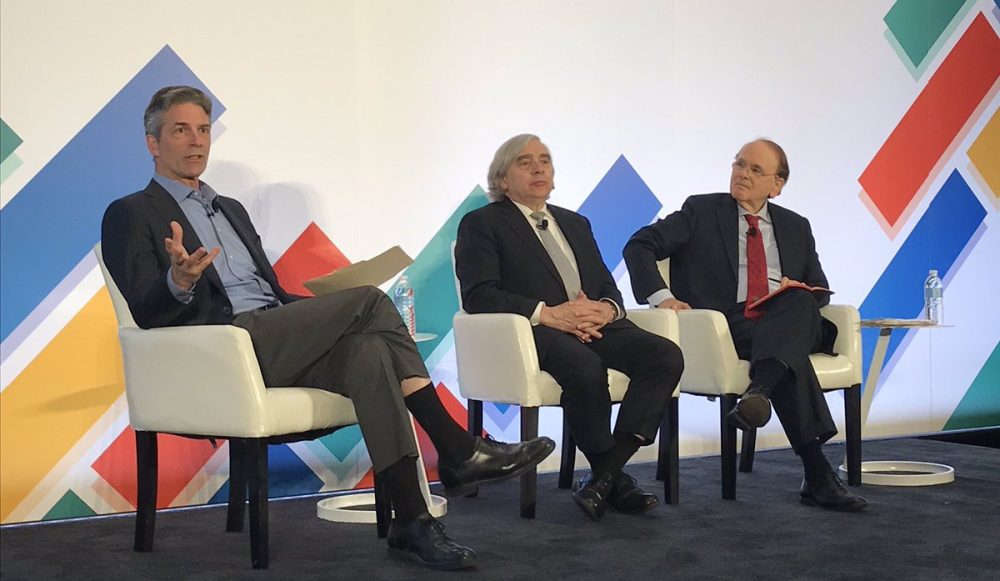Clean energy transition needs more breakthrough innovations, experts say

PHILADELPHIA – Innovation in technology, business models and policy, along with existing technologies, will be crucial to achieving clean energy goals, leading energy experts said.
Ernest Moniz, president and CEO of Energy Futures Initiative (EFI) and former Secretary of the U.S. Department of Energy (DOE), emphasized the importance of technology innovation earlier this week during a panel discussion at the Edison Electric Institute’s (EEI) annual conference in Philadelphia.
“I would say in that space of innovation, technology innovation that lowers costs and provides new options is maybe the key enabler of all …” Moniz said.
Moniz discussed a “Green Real Deal” and said that a program to lower carbon emissions must be pragmatic, scientific, region-specific and must have innovation at its core.
Moniz and Daniel Yergin, vice chairman of IHS Markit, along with moderator Gerard Anderson, chairman and CEO of DTE Energy, also discussed a recent report led by Moniz and Yergin titled Advancing the Landscape of Clean Energy Innovation. The report, which was commissioned by Breakthrough Energy, examines energy technologies and identifies 10 high-priority clean energy innovation areas.
The panelists noted that while we will eventually need breakthrough technologies, existing technologies, such as natural gas and nuclear, will continue to play an important role into the future and will help support the clean energy transition. Energy “incumbents” and “disruptors” will need to work together to succeed in the clean energy transition, Moniz said.
“I find it’s still hard to see that gas is not going to be an important fuel for some time…” Yergin said.
To accomplish 2050 goals, Moniz noted, we will need breakthrough technologies to be developed and scaled. One such technology the panelists discussed is carbon direct removal, which involves technologies that remove carbon from the atmosphere or oceans as well as carbon sequestration technologies.
“I would say flat out if you talk about net carbon neutral, you can not get there without negative carbon technologies,” Moniz said.
Moniz noted that the EFI will be releasing a report on carbon direct removal in July.
The panel also discussed long-term storage, noting that while short-term storage such as modern battery technology is important, we will also need long-term storage to support the clean energy transition.
California, Moniz said, has approximately twice as much solar and more than twice as much wind in the summer than in the winter. This means that you need a way to store energy and move it between seasons. Doing so requires a fuel, Moniz said, which could be a low-carbon fuel such as hydrogen.
While hydrogen technologies are not yet affordable, Moniz recommended starting to build the end use market for hydrogen today and said that with enough research and development, the technology could be available relatively soon.
“But it’s all innovation, and by mid-century there’s no reason why we can’t have lots of clean hydrogen,” Moniz said.
The panel also discussed innovation in the nuclear energy sector. Moniz said he believes that passively safe modular reactors will play an important role in the future.
“We have never had more innovation in the nuclear business … than we have today,” Moniz said. “But where we have not done the innovation is the financial engineering,” he continued, noting that federal involvement, whether through incentives, long-term power purchase agreements or other mechanisms, will be important to the nuclear industry.
Moniz and Yergin also discussed carbon reduction in other sectors such as the industrial sector and the transportation sector, which now generate the largest share of greenhouse gas emissions.
Yergin noted that, according to recent research, 189 ZIP codes, which are all located in three counties in California, account for 25 percent of all U.S. electric vehicle (EV) sales. The United States has 43,000 ZIP codes.
Moniz said that the operating costs of EVs are expected to be comparable to internal combustion vehicles in the near future although the capital costs may still be higher and suggested focusing on EV applications in which operating costs play a larger role such as delivery and public transportation.
